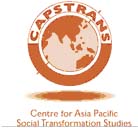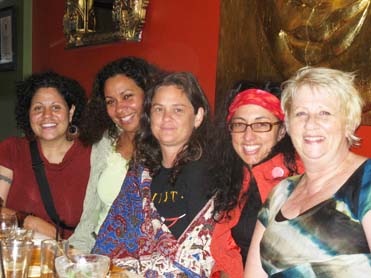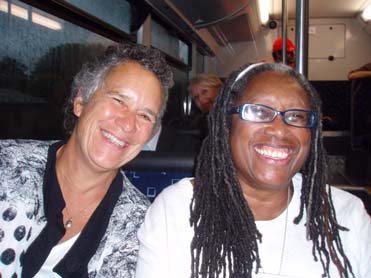

 23–24 November 2009,
23–24 November 2009,
University of Wollongong ARC APFRN Application: Theme: Constructing Economic Foundations for the Future (Trade and Industry) 
Figure 1. 'Big Island 'Workshop participants at University of Wollongong (Photo: Mark Newsham) This workshop was developed in response to the cultural and economic situation of contemporary artists of Pacific origin residing in Australia. While the artistic output of artists in this sector is extraordinarily dynamic and diverse, it often remains marginalised, both within mainstream Australian art and the academic sphere of Pacific Studies. A major contributing factor to the lack of information about Pacific cultures throughout Australia ('the Big Island') has been a dearth of critical art literature and specific curatorial expertise. Consequently, much Pacific art activity is currently confined to regional, rather than metropolitan centres, thus limiting potential audiences in the Big Island, the smaller Pacific Islands and the world beyond. The workshop was organised to
This funding enabled the meeting, for perhaps the first time in Australia, of a diverse range of seventeen contemporary Pacific, Indigenous and non-Indigenous artists and craftspersons, critics, scholars (including four PhD candidates), independent and institutional curators, gallery directors, independent art consultants, a national art journal editor, a poet, poet, a professor of information systems and technology and a commercial art dealer/curator completing a PhD on cultural economics. Travelling from across Australia, the US, and New Zealand, the participants and attendees included Dr Karen Stevenson (Christchurch, Aotearoa-NZ); Torika Bolatagici (Melbourne); David Broker, Gary Lee, Maurice O'Riordan (Canberra); Dr. Susan Cochrane, Ross Searle, Joycelin Leahy (Brisbane); Jenny Fraser (Darwin); Lisa Havilah (Campbelltown); Dr Jacquelyn Lewis-Harris (St Louis, USA); Keren Ruki (Sydney); Dr Pamela Zeplin (Adelaide), with Auntie Barbara Nicholson, Dr Peter Eklund, Annalise Friend and A/P Paul Sharrad (Wollongong). Other universities represented were Deakin University, University of Queensland, the Australian National University, University of South Australia, University of New South Wales, Washington University, St. Louis, USA, and University of Canterbury (Aotearoa New Zealand), along with significant arts institutions (Campbelltown Regional Arts Centre, Art Monthy and Canberra Contemporary Art Space). A number of independent scholars/consultants have also been associated with major Australian and Pacific universities and museums. 
Figure 2. The end of the workshop. 'Big Island' participants, University of Wollongong, November 24 2009 (Photo: Joycelin Leahy) One of the major benefits of the workshop was the chance for independent practitioners, curators, scholars and small arts business owners, who are often isolated in their various sites of work, to come together with PhD candidates and their institutionally based counterparts. Even the latter group often experience marginality in their field so this occasion allowed for discovery of common interests and collegiality, and the opportunity to take advantage of cultural and political 'critical mass'. Including predominantly Pacific/Aotearoa New Zealand and Indigenous participants with cultural heritages from Fiji, PNG, Aotearoa New Zealand (Pakeha, Maori and Tahitian), Australian South Sea Islander, Aboriginal Australian (Larrakia, Bandjalang and Wadi Wadi people), African American and non-Indigenous Australians, the workshop was diverse and lively, with a structured but informal two-day program. At Wollongong each guest presented a half-hour paper/performance, with Zeplin and Sharrad chairing. Keynote speaker, Dr Karen Stevenson shared her long history of participation in Australian-Pacific relations which provided instructive comparisons with developments across the Tasman. Her paper interrogated notions of 'contemporary' art and its capacity to accommodate diverse 'traditional' practices. Similarly, anthropologist, Dr Jacqueline Lewis-Harris' research has contributed significant understanding of regional, in particular, PNG-Australian culture in the work of the late Wendy Choulai. Dr Susan Cochrane's vast experience of and support for Pacific visual culture is currently focused around planning a major PNG-Australian National Museum exhibition and workshop initiative. Workshop participation was intensive and represented a richly diverse 'community' of Pacific interest and expertise; some participants were already known to each other, many were acquainted with each other's work and a few brought radical new perspectives to the discussion. A particular privilege was the chance to preview in a presentation by Dr Peter Eklund (The Centre for Digital Ecosystems, University of Wollongong) the Australian Museum's virtual catalogue of Pacific materials – the day before its national launch. This is a project conducted jointly with the Faculty of Creative Arts and its Dean, Prof Amanda Lawson. A dedicated focus on different ways of working was found to be more productive than formal conference-format presentations, allowing a free flow of discussion. Prior to the event, participants were invited to prepare a thesis chapter, essay or article draft to be circulated to everyone in advance. This opportunity was mostly taken up by PhD candidates who appreciated having their work critiqued by a panel of experienced professionals with long-standing expertise in the field. Their studies included women in hip hop (Annalise Friend), identity and authenticity in the Pacific Diaspora (Torika Bolatagici) and professional development opportunities for emerging Pacific curators and artists (Joycelin Leahy). The exchange of ideas around a wide and interdisciplinary range of papers - and performance - was dynamic, informed and, most importantly, genuinely convivial and supportive within a context of lively and passionate debate. Without the need to 're-invent the wheel' or justify positions, participants got on with the job of forging new collaborative links between different generations and various creative roles, as well as strengthening and expanding existing connections. Other stimulating topics included: Indigenous-Pacific identities; South Sea Islander connections in Pacific Storms; curating The Other APT; Pacific communities in regional suburbia; historical Australian perspectives on exhibiting the Pacific; Indigenous and Pacific residency programs. A final plenary session allowed various threads arising over the two days to be drawn together and the overall situation of Pacific-Indigenous art canvassed. Participants developed a range of priorities, resources and strategies to assist each other – and others in the field – in future activities. Among other art and museum-focused institutions, the AAAPS and the Australian National University were broadcast as important sites of information and dissemination. Contacts were cemented with several regional galleries and museums, Pacific Art Alliance, and the AAAPS network.
As a result of the workshop, Art Monthly plans a special 'Pacific Issue' and publication of selected papers from the workshop. This national journal immediately issued a press release following the workshop, which was electronically disseminated nationally and internationally, and forwarded to blogs, newsletters, and a wide range of Pacific sites, including AAAPS,[3] by 'Big Island' participants; Torika Bolatagici[4]; and Canberra Contemporary Art Space (CCAS). From this media saturation Radio Australia broadcast an interview with Indigenous participant, Jenny Fraser[5] while a number of the workshop group are collaboratively planning future exhibitions and projects as well as presentations in a special 'Digital Stories' panel at the forthcoming AAAPS Conference, Oceanic Transformations and the 2010 Pacific Arts Association Conference, Pacific Art in the 21st Century: Museums, New Global Communities and Future Trends in Rarotonga Cook Islands. Following the workshop, unsolicited comments from participants were very positive, indicating its generative effect as a catalyst for action. Art Monthly Editor, Maurice O'Riordan noted in his press release: 'Though relatively small in scale, the workshop was decidedly big on expertise, talent and ideas…' Endnotes [1] Dr Pamela Zeplin is Portfolio Leader of Research Education, Art, Architecture and Design at the University of South Australia. [2] Assoc. Prof. Paul Sharrad lectures in English Studies at the University of Wollongong. [3] Big Ideas for a Big Island: Critical workshop in Wollongong tests the waters on future directions for Pacific arts, AAAPS, 26 November 2009. [4] Big Ideas for a Big Island – Media Release, torika bolatagici, 26 November 20009. [5] Interview with Jenny Fraser, In the Loop, ABC Radio Australia. |
|
 Figure 3.'Big Island' Workshop Dinner. From Left Torika Bolatagici, Joycelin Leahy, Jenny Fraser, Keren Ruki, Pamela Zeplin
Figure 3.'Big Island' Workshop Dinner. From Left Torika Bolatagici, Joycelin Leahy, Jenny Fraser, Keren Ruki, Pamela Zeplin
 Figure 4. From Left: Karen Stevenson and Jacki Lewis-Harris (Photo: David Broker)
Figure 4. From Left: Karen Stevenson and Jacki Lewis-Harris (Photo: David Broker)